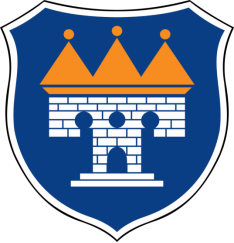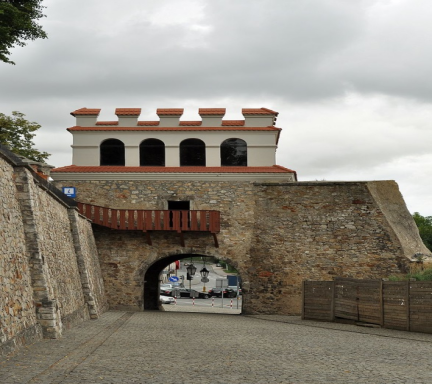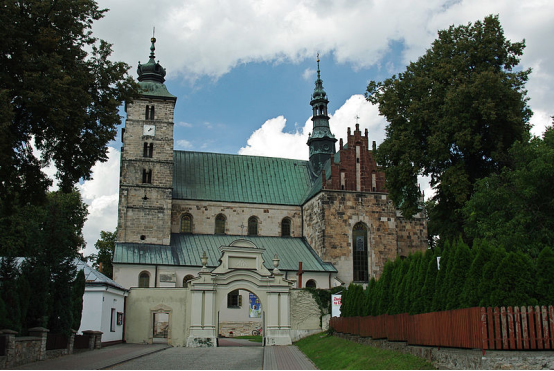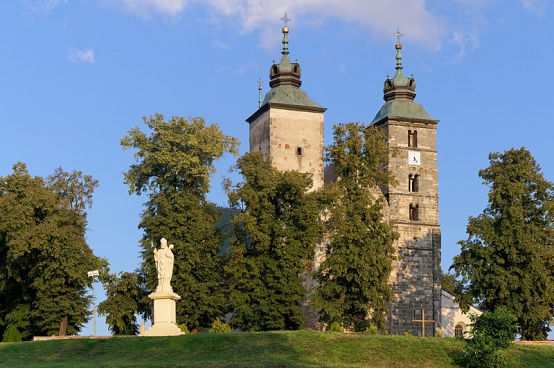Opatów-Świętokrzyskie 作者: 来源: 发布时间:2021-10-27
Ⅰ. Population and Area
Population (2012)
• Total 6,658
• Density 710/km2 (1,800/sq mi)
Area
• Total 9.36 km2 (3.61 sq mi)
Website http://www.umopatow.pl/

Ⅱ.Natural Geography (environment and resources)

-Opatów is located in the Sandomierz Upland, on hills with a height of 200 to 300 m above sea level. The Jeleniowskie and Iwaniskie ranges of the Świętokrzyskie Mountains are nearby. The Opatówka River flows through the city, dividing it into two parts and crossing it with a deep valley.
-Opatów is located at the intersection of routes No. 9 (E371) Radom - Rzeszów and No. 74 Wieluń - Zosin (border with Ukraine ). The provincial road No. 757 Opatów - Stopnica starts in Opatów .
-According to data from 1 January 2011, the area of the city was 9.36 km²
-The Opatów Commune is situated within two units of the Kielce-Sandomierska Upland: the Sandomierz Upland mesoregion (Opatowska) and the Świętokrzyskie Mountains mesoregion. The border runs through the villages from Jałowąs through Jurkowice, Kochów, Kobylany. The Świętokrzyskie Mountains mesoregion covers a small western part of the commune, where the absolute heights are within 240 - 330 m. In the vicinity of Opatów, on its south-western side, there are two ranges of the Świętokrzyskie Mountains: Jeleniowskie and Wygiełzowskie. Administratively, the Opatów commune has belonged to the Świętokrzyskie Province since 1999. The authorities of Opatów County are located in Opatów. The Opatów Commune borders the communes of: Sadowie, Ćmielów, Wojciechowice, Lipnik, Iwaniska and Baćkowice.
-Transport
-The town marks the intersection of two main roads - European route E371, and national road nr 74 (Piotrków Trybunalski – Hrubieszów). Opatów, however, has no rail connection. Nearest station is at Ostrowiec Świętokrzyski, 17 km (11 mi) away.
-Opatów – Airports nearby
-Radom Airport (41.7 miles / 67.2 kilometers)
-Rzeszów–Jasionka Airport (54.5 miles / 87.6 kilometers)
-Lublin Airport (63.8 miles / 102.6 kilometers)
-Kraków John Paul II International Airport (87.9 miles / 141.4 kilometers)
Ⅲ.Economy
-Area: 113.39 km2, of which the city covers 9.36 km2
-Population: 12,373 inhabitants of the commune, including 6,800 in the city of Opatów (as of December 31, 2012).
-Population density index (2007): in the city it is 680 people / km2, and in the commune - 110 people / km2.
-The budget of the commune per capita in 2007 was as follows: income - PLN 1754, expenses - PLN 1718. Traditional professions and sources of income: agriculture on farms, crafts, services, trade.
-Preferred forms of entrepreneurship: processing - agri-food, services, including tourist services.
-Agricultural land: total 9,580 ha, including: arable land 8,971 ha, i.e. 86.5% of agricultural land, total number of farms and estates - 1,820, including farms - 1,290.
-http://www.umopatow.pl/index.php/miasto/gmina-w-liczbach
Ⅳ.Industrial Characteristics
-After the war, the city developed textiles and food manufacturing industries. The new housing estate and a Cultural Centre were built. Currently, the city sees its opportunities in the further development of tourism. However, there is no train station in Opatów – the nearest station is in Ostrowiec, 17 kilometres (11 mi) distance. Communication network consists of a city bus and private bus companies. The key focus areas of municipal government are the development of technical infrastructure, tourism, small business, attracting investors, and the promotion of education as well as the city itself. Traditional occupations and sources of income include agricultural farms, crafts, services and trade. The main directions of city and commune development: development of technical infrastructure, development of tourism, small enterprise, attracting investors, education development, commune promotion.
-https://en.wikipedia.org/wiki/Opat%C3%B3w#Economy
-http://www.umopatow.pl/index.php/miasto/gmina-w-liczbach
-Key projects
-1. The project "Świętokrzyski Bus Driver"
-http://www.umopatow.pl/index.php/wszystkie-aktualnosci/457-projekt-swietokrzyski-kierowca-autobusu
-2. Information on the Clean Air program
-Clean Air is a program aimed at improving air quality and reducing greenhouse gas emissions by replacing heat sources and energy efficiency in single-family residential buildings. As part of the program, it is possible to subsidize the purchase and installation of a heat source and to conduct thermal modernization of the building.
-http://www.umopatow.pl/index.php/wszystkie-aktualnosci/450-informacja-na-temat-programu-czyste-powietrze
Ⅴ.Attrations and Cityscape

Remains of defensive walls with the Warsaw Gate

Romanesque collegiate church st. Martin (12th century)

Collegiate church in Opatów
-There are many historical monuments included in the list of monuments in the city:
-The urban layout, entered in the register of immovable monuments (registration number: A.527 of May 16, 1947 and May 8, 1985).
-Collegiate Church of St. Martin, a Romanesque- style temple from the second half of the 12th century, in 2006 celebrating the 800th anniversary of granting the status of a collegiate church; It houses a number of unique monuments, e.g. the Lament Opatowski cast in bronze , depicting the despair of 41 inhabitants of Opatów after the death of Krzysztof Szydłowiecki, next to the chancellor's tombstone there is also a tombstone of his daughter and the tombstones of his two sons. In addition, on the walls of the collegiate church, there are paintings depicting scenes of famous battles - the Viennese Relief, Psie Pole and Grunwald. Also valuable are 18th-century benches and stalls, as well as an organ, a work of organ art. Registered number: A.528 / 1-3 of October 18, 1956, June 21, 1967 and June 16, 1977.
-Remains of city walls erected by Chancellor Krzysztof Szydłowiecki with the only preserved gate - the Warsaw Gate; registration no: A.536 / 1-2 of May 30, 1972 and June 16, 1977。
-The baroque monastery of Bernardynów erected in the 14th and 15th centuries on the site of the Żmigród settlement. He is famous for heroic defense invasion during said Tatar in the sixteenth century. Inside is particularly interesting rococo altar, l'oeil altar side of one compressor Mystic, and renovated wall paintings. Registered number: A.529 / 1-3 of October 18, 1956, June 21, 1967 and June 16, 1977.
-Underground Opatów - a system of former merchant cellars carved in the loess under the old town square (Plac Obrońców Pokoju).
-Former synagogue at ul. Szeroka, near the market square (currently no longer exists).
-House with arcades in the Market Square from the 16th century, destroyed during World War II and rebuilt after the war, now the town hall ( town hall ). Registered number: A.537 of October 14, 1949 and October 28, 1971.
-The chapel of St. John of Nepomuk from the turn of the 18th and 19th centuries - wooden, with a shingled tent roof, under which there is a figure of the saint. Renovated in the 1990s, and then in 2012.
-Jewish Matzevas
-The symbolic grave of Ludwik Topór-Zwierzdowski , an insurgent from 1863 (registration number: A.535 of May 24, 1993).
-Insurgents' grave from 1863 (registration number: A.533 of May 24, 1993).
-Fr. Przybyłowski , an insurgent from 1863 (registration number: A.534 of May 24, 1993).
-The parish cemetery (registration number: A.530 from June 17, 1988).
-War cemetery from World War I (register number: A.531 of May 16, 1988).
-Lapidarium in the area of the former Jewish cemetery, now a municipal park (reg.No: A.532 of April 22, 1991).
Ⅵ.History and Culture
-In the Middle Ages, Opatów was a settlement on the Opatówka River, in an area of forests and lakes. First mentioned in 1189, it was the residence of the regional ruler (Castellan) and one of the largest settlements of the Sandomierz Land. First church was built here sometime in the 11th century. In the 12th century, St. Martin collegiate church was built as well. The purpose of the collegiate church is not known, it was probably designed for a Roman Catholic diocese which was created in Sandomierz instead.
-In 1232, prince Henryk Brodaty transferred Opatów to Lawrence, Bishop of Lubusz. In 1237, it was granted privileges that regularized the status of its residents and in 1361 it received the status of a city with wide privileges. In the first half of the 14th century, Bishop of Lubusz Stefan II decided to move the center of the town to the hill near the collegiate church. New town was called Great Opatów (Opatów Wielki), also Magnum Oppathow and Magna Opatow.
-For centuries, until the Partitions of Poland, Opatów was an important regional center of Lesser Poland. During an invasion of the Tartars (1502), the town was destroyed. In 1514, it was transferred to Krzysztof Szydłowiecki, who restored it, surrounded with a defensive wall, built a castle and offices for the local government, and improved the water supply to the residents. Opatów had two annual fairs and two market days a week. In the 16th century, Opatów had a population of roughly 4,000 and was the biggest town of the province, even bigger than Sandomierz. The town was a center of political life of the Voivodeship; here General Sejmiks of the Lesser Poland Szlachta nobility took place. In 1551 Opatów burned almost completely. The great fire marked a slow decline of the town. In 1655, Opatów was destroyed in the Swedish invasion of Poland. The town also suffered during other conflicts including the Great Northern War, the Bar Confederation, the Polish–Russian War of 1792, and the Kościuszko Uprising. It belonged to a number of noble families (Tarnowski family, Ostrogski family, Lubomirski family, Potocki family, and Karski family), and remained in private hands until 1864.
-In the 18th century, Opatów became home to a number of Greeks, who had escaped to Poland from the Turkish occupation of their homeland (see Ottoman Greece). They were allowed to open Orthodox churches. In 1778, an Orthodox parish of St Nicholas was opened, which in 1837 was moved to Radom. During the January Uprising, two battles took place in Opatów between Russians and II Corps of General Józef Hauke-Bosak. Poles captured the town on November 25, 1863, and withdrew with seized Russian guns and ammunition. On February 21, 1864, the second battle took place. It was one of the largest skirmishes of the uprising, and it ended in Polish defeat.
-Jewish community of Opatów
-Opatów was the first town in the Sandomierz Voivodeship, in which Jews settled. The original Jewish privileges were issued in 1545 by the Grand Crown Hetman Jan Tarnowski, the starost of Sandomierz and the owner of Opatów.[1] Local Jewish community was first mentioned in the books of the Roman Catholic ecclesiastical Chapter in 1612.
-Prior to World War II, Opatów had a substantial Jewish population. Known as 'Apt' in Yiddish, Opatów became home to 6,000 Jews with a history of rich cultural and religious life. Best known from among the locals was the 18th century Rabbi Avraham Yehoshua Heshel (Apter Rebbe), who was instrumental in the development of the Chasidic movement, and the famous Noda Be'Yehuda of Prague, one of the leading halakhic authorities of 18th Century Europe. Jewish life in Apt has been chronicled by Professor Gershon Hundert in his 1992 book The Jews in a Private Polish Town, drawing upon a variety of sources from the history of Jews in Poland. The work describes the demographic and historical background as well as the structure of the Jewish community of Apt (Opatów) with a population numbering about 2,000 in 1765, exceptionally large for any Jewish shtetl in the 18th century Europe. The town's Jewish inhabitants enjoyed considerable prominence also in the following centuries. Hundert uses the Jewish Opatów as a case study for Polish Jewry. More than three-quarters of them lived on private lands of powerful magnate aristocrats known as the Szlachta. Hundert's work also describes the vibrant interaction of the Jews of Apt with their Polish Christian neighbours. It is a challenge to previous historiography which describes Jewish life in Poland in alleged isolation.
-During World War II the community was herded into the new Opatów Ghetto set up by the Nazis along the Joselewicza, Zatylna, Wąska and Starowałowa Streets. The ghetto held about ten thousand Jews. It was destroyed during the Holocaust in Poland, with about 8,000 Ghetto inmates deported to Treblinka extermination camp throughout October 1942 and additional 2,000 Jews sent to labour camps never to return. Only about 300 of Opatów's pre-war Jewish population of around 5000 survived.
-Opatów was a large center of the underground resistance in World War II. On the night of March 12/13 1943, a unit of Jędrusie, together with soldiers of the Home Army, attacked the local prison, releasing 82 inmates.
Ⅶ.Other Information
-Opatów - a city in the voivodeship Świętokrzyskie , in Opatów County . It is the seat of the poviat as well as the urban-rural commune of Opatów .
-The town in the former Sandomierz Province was owned by Mikołaj Krzysztof Radziwiłł (Sierotka) in the years 1576–1578. In the years 1975–1998 the city administratively belonged to the province. Tarnobrzeg.
-According to data from January 1, 2018, Opatów had 6,516 inhabitants.
-The city is located in Lesser Poland , in the Sandomierz region
Ⅷ.Contact Information
-Contact number
-Mayor Grzegorz Gajewski (since 2018)
-tel. 15 8681300
-fax. 15 8684647
-e-mail: Opatow@umopatow.pl
